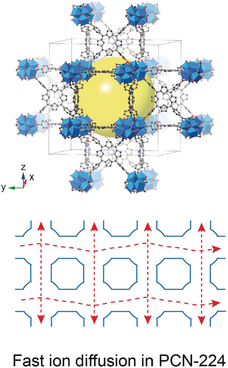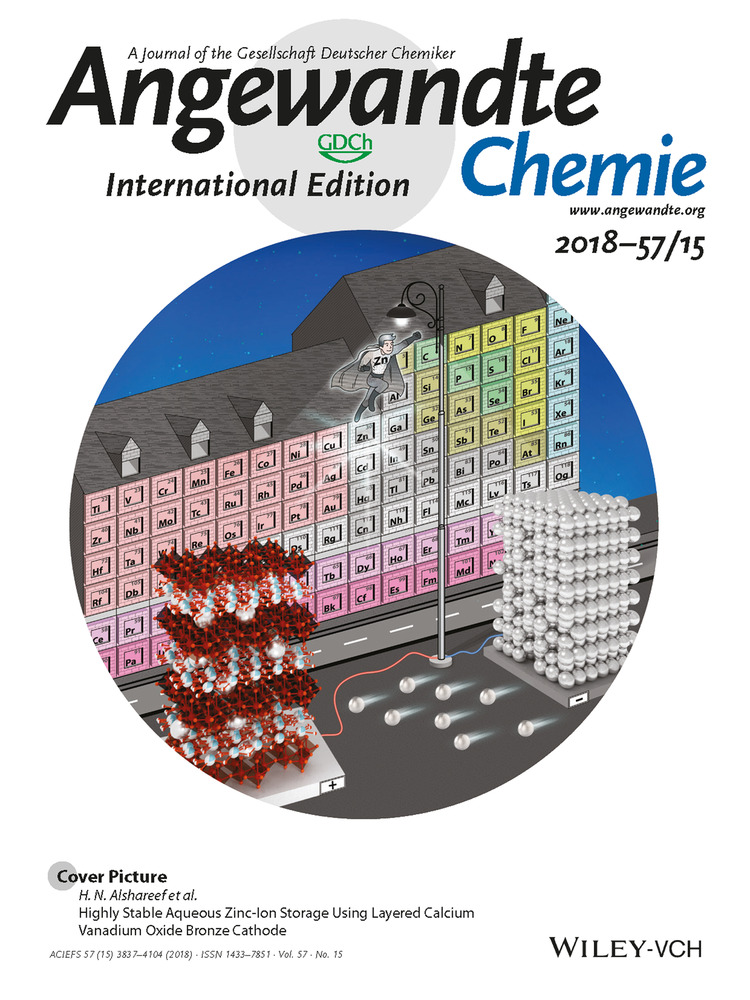Metal–Organic Frameworks for High Charge–Discharge Rates in Lithium–Sulfur Batteries
Haoqing Jiang
Key Laboratory of Biomedical Polymers—Ministry of Education, College of Chemistry and Molecular Science, Wuhan University, Wuhan, 430072 PR China
These authors contributed equally to this work.
Search for more papers by this authorXiao-Chen Liu
Key Laboratory of Biomedical Polymers—Ministry of Education, College of Chemistry and Molecular Science, Wuhan University, Wuhan, 430072 PR China
These authors contributed equally to this work.
Search for more papers by this authorYushan Wu
Key Laboratory of Biomedical Polymers—Ministry of Education, College of Chemistry and Molecular Science, Wuhan University, Wuhan, 430072 PR China
Search for more papers by this authorYufei Shu
Key Laboratory of Biomedical Polymers—Ministry of Education, College of Chemistry and Molecular Science, Wuhan University, Wuhan, 430072 PR China
Search for more papers by this authorXuan Gong
Key Laboratory of Biomedical Polymers—Ministry of Education, College of Chemistry and Molecular Science, Wuhan University, Wuhan, 430072 PR China
Search for more papers by this authorCorresponding Author
Prof. Fu-Sheng Ke
Key Laboratory of Biomedical Polymers—Ministry of Education, College of Chemistry and Molecular Science, Wuhan University, Wuhan, 430072 PR China
Search for more papers by this authorCorresponding Author
Prof. Hexiang Deng
Key Laboratory of Biomedical Polymers—Ministry of Education, College of Chemistry and Molecular Science, Wuhan University, Wuhan, 430072 PR China
UC Berkeley-Wuhan University Joint Innovative Center, The Institute for Advanced Studies, Wuhan University, Wuhan, 430072 PR China
Search for more papers by this authorHaoqing Jiang
Key Laboratory of Biomedical Polymers—Ministry of Education, College of Chemistry and Molecular Science, Wuhan University, Wuhan, 430072 PR China
These authors contributed equally to this work.
Search for more papers by this authorXiao-Chen Liu
Key Laboratory of Biomedical Polymers—Ministry of Education, College of Chemistry and Molecular Science, Wuhan University, Wuhan, 430072 PR China
These authors contributed equally to this work.
Search for more papers by this authorYushan Wu
Key Laboratory of Biomedical Polymers—Ministry of Education, College of Chemistry and Molecular Science, Wuhan University, Wuhan, 430072 PR China
Search for more papers by this authorYufei Shu
Key Laboratory of Biomedical Polymers—Ministry of Education, College of Chemistry and Molecular Science, Wuhan University, Wuhan, 430072 PR China
Search for more papers by this authorXuan Gong
Key Laboratory of Biomedical Polymers—Ministry of Education, College of Chemistry and Molecular Science, Wuhan University, Wuhan, 430072 PR China
Search for more papers by this authorCorresponding Author
Prof. Fu-Sheng Ke
Key Laboratory of Biomedical Polymers—Ministry of Education, College of Chemistry and Molecular Science, Wuhan University, Wuhan, 430072 PR China
Search for more papers by this authorCorresponding Author
Prof. Hexiang Deng
Key Laboratory of Biomedical Polymers—Ministry of Education, College of Chemistry and Molecular Science, Wuhan University, Wuhan, 430072 PR China
UC Berkeley-Wuhan University Joint Innovative Center, The Institute for Advanced Studies, Wuhan University, Wuhan, 430072 PR China
Search for more papers by this authorGraphical Abstract
MOF host S: The electrical conductivity of metal–organic frameworks (MOFs) was promoted by the construction of polymer–MOF composites. Using MOF-based sulfur hosts, the critical role of porosity at high charge–discharge rates in Li–S batteries was elucidated. MOFs with short ion transfer pathways and large pore apertures were identified as the most suitable for long-term cycling at extremely high rates.
Abstract
We report a new method to promote the conductivities of metal–organic frameworks (MOFs) by 5 to 7 magnitudes, thus their potential in electrochemical applications can be fully revealed. This method combines the polarity and porosity advantages of MOFs with the conductive feature of conductive polymers, in this case, polypyrrole (ppy), to construct ppy-MOF compartments for the confinement of sulfur in Li–S batteries. The performances of these ppy-S-in-MOF electrodes exceed those of their MOF and ppy counterparts, especially at high charge–discharge rates. For the first time, the critical role of ion diffusion to the high rate performance was elucidated by comparing ppy-MOF compartments with different pore geometries. The ppy-S-in-PCN-224 electrode with cross-linked pores and tunnels stood out, with a high capacity of 670 and 440 mAh g−1 at 10.0 C after 200 and 1000 cycles, respectively, representing a new benchmark for long-cycle performance at high rate in Li–S batteries.
Supporting Information
As a service to our authors and readers, this journal provides supporting information supplied by the authors. Such materials are peer reviewed and may be re-organized for online delivery, but are not copy-edited or typeset. Technical support issues arising from supporting information (other than missing files) should be addressed to the authors.
| Filename | Description |
|---|---|
| anie201712872-sup-0001-misc_information.pdf1.7 MB | Supplementary |
Please note: The publisher is not responsible for the content or functionality of any supporting information supplied by the authors. Any queries (other than missing content) should be directed to the corresponding author for the article.
References
- 1
- 1aN. L. Rosi, J. Eckert, M. Eddaoudi, D. T. Vodak, J. Kim, M. O'keeffe, O. M. Yaghi, Science 2003, 300, 1127–1129;
- 1bS. Horike, R. Matsuda, D. Tanaka, M. Mizuno, K. Endo, S. Kitagawa, J. Am. Chem. Soc. 2006, 128, 4222–4223;
- 1cY. He, B. Li, M. O'Keeffe, B. Chen, Chem. Soc. Rev. 2014, 43, 5618–5656;
- 1dJ. R. Li, R. J. Kuppler, H. C. Zhou, Chem. Soc. Rev. 2009, 38, 1477–1504;
- 1eE. D. Bloch, W. L. Queen, R. Krishna, J. M. Zadrozny, C. M. Brown, J. R. Long, Science 2012, 335, 1606–1610;
- 1fJ. An, S. J. Geib, N. L. Rosi, J. Am. Chem. Soc. 2010, 132, 38–39;
- 1gC. He, K. Lu, D. Liu, W. Lin, J. Am. Chem. Soc. 2014, 136, 5181–5184;
- 1hZ. Dong, Y. Sun, J. Chu, X. Zhang, H. Deng, J. Am. Chem. Soc. 2017, 139, 14209–14216.
- 2
- 2aK. M. Choi, H. M. Jeong, J. H. Park, Y. B. Zhang, J. K. Kang, O. M. Yaghi, ACS Nano 2014, 8, 7451–7457;
- 2bD. Wu, Z. Guo, X. Yin, Q. Pang, B. Tu, L. Zhang, Y.-G. Wang, Q. Li, Adv. Mater. 2014, 26, 3258–3262;
- 2cD. Sheberla, J. C. Bachman, J. S. Elias, C. J. Sun, Y. Shao-Horn, M. Dincă, Nat. Mater. 2017, 16, 220–224;
- 2dF. S. Ke, Y. S. Wu, H. Deng, J. Solid State Chem. 2015, 223, 109–121;
- 2eA. A. Talin, A. Centrone, A. C. Ford, M. E. Foster, V. Stavila, P. Haney, M. D. Allendorf, Science 2014, 343, 66–69.
- 3
- 3aJ. A. Hurd, R. Vaidhyanathan, V. Thangadurai, C. I. Ratcliffe, I. L. Moudrakovski, G. K. Shimizu, Nat. Chem. 2009, 1, 705–710;
- 3bI. Stassen, N. Burtch, A. Talin, P. Falcaro, M. Allendorf, R. Ameloot, Chem. Soc. Rev. 2017, 46, 3185–3241;
- 3cG. Wu, J. Huang, Y. Zang, J. He, G. Xu, J. Am. Chem. Soc. 2017, 139, 1360–1363.
- 4
- 4aG. Férey, C. Mellot-Draznieks, C. Serre, F. Millange, J. Dutour, S. Surblé, I. Margiolaki, Science 2005, 309, 2040–2042;
- 4bG. Férey, M. Latroche, C. Serre, F. Millange, T. Loiseau, A. Percheron-Guégan, Chem. Commun. 2003, 2976–2977;
- 4cD. Feng, W. C. Chung, Z. Wei, Z. Y. Gu, H. L. Jiang, Y. P. Chen, D. J. Darensbourg, H. C. Zhou, J. Am. Chem. Soc. 2013, 135, 17105–17110.
- 5
- 5aX. Ji, K. T. Lee, L. F. Nazar, Nat. Mater. 2009, 8, 500–506;
- 5bY. Yang, G. Zheng, Y. Cui, Chem. Soc. Rev. 2013, 42, 3018–3032;
- 5cY. S. Su, A. Manthiram, Nat. Commun. 2012, 3, 1166;
- 5dS. Xin, L. Gu, N. H. Zhao, Y. X. Yin, L. J. Zhou, Y. G. Guo, L. J. Wan, J. Am. Chem. Soc. 2012, 134, 18510;
- 5eJ. Song, M. L. Gordin, T. Xu, S. Chen, Z. Yu, H. Sohn, J. Lu, Y. Ren, Y. Duan, D. Wang, Angew. Chem. Int. Ed. 2015, 54, 4325–4329; Angew. Chem. 2015, 127, 4399–4403;
- 5fL. Ji, M. Rao, S. Aloni, L. Wang, E. J. Cairns, Y. Zhang, Energy Environ. Sci. 2011, 4, 5053–5059;
- 5gQ. Sun, X. Fang, W. Weng, J. Deng, P. Chen, J. Ren, G. Guan, M. Wang, H. Peng, Angew. Chem. Int. Ed. 2015, 54, 10539–10544; Angew. Chem. 2015, 127, 10685–10690;
- 5hY. Yang, G. Yu, J. J. Cha, H. Wu, M. Vosgueritchian, Y. Yao, Z. Bao, Y. Cui, ACS Nano 2011, 5, 9187–9193;
- 5iL. Xiao, Y. Cao, J. Xiao, B. Schwenzer, M. H. Engelhard, L. V. Saraf, Z. Nie, J. E. Gregory, J. Liu, Adv. Mater. 2012, 24, 1176–1181;
- 5jW. Zhou, Y. Yu, H. Chen, F. J. DiSalvo, H. D. Abruña, J. Am. Chem. Soc. 2013, 135, 16736–16743.
- 6
- 6aR. Demir-Cakan, M. Morcrette, F. Nouar, C. Davoisne, T. Devic, D. Gonbeau, R. Dominko, C. Serre, G. Férey, J. M. Tarascon, J. Am. Chem. Soc. 2011, 133, 16154–16160;
- 6bJ. Zheng, J. Tian, D. Wu, M. Gu, W. Xu, C. Wang, F. Gao, M. H. Engelhard, J.-G. Zhang, J. Liu, J. Xiao, Nano Lett. 2014, 14, 2345–2352;
- 6cZ. Wang, B. Wang, Y. Yang, Y. Cui, Z. Wang, B. Chen, G. Qian, ACS Appl. Mater. Interfaces 2015, 7, 20999–21004.
- 7
- 7aW. Xia, A. Mahmood, R. Zou, Q. Xu, Energy Environ. Sci. 2015, 8, 1837–1866;
- 7bH. B. Wu, S. Wei, L. Zhang, R. Xu, H. H. Hng, X. W. D. Lou, Chem. Eur. J. 2013, 19, 10804–10808;
- 7cY. J. Li, J. M. Fan, M. S. Zheng, Q. F. Dong, Energy Environ. Sci. 2016, 9, 1998–2004;
- 7dZ. Li, C. Li, X. Ge, J. Ma, Z. Zhang, Q. Li, C. Wang, L. Yin, Nano Energy 2016, 23, 15–26;
- 7eY. Liu, G. Li, J. Fu, Z. Chen, X. Peng, Angew. Chem. Int. Ed. 2017, 56, 6176–6180; Angew. Chem. 2017, 129, 6272–6276;
- 7fG. P. Hao, C. Tang, E. Zhang, P. Zhai, J. Yin, W. Zhu, Q. Zhang, S. Kaskel, Adv. Mater. 2017, 29, 1702829.
- 8
- 8aS. Yang, J. Sun, A. J. Ramirez-Cuesta, S. K. Callear, W. I. David, D. P. Anderson, R. Newby, A. J. Blake, J. E. Parker, C. C. Tang, M. Schröder, Nat. Chem. 2012, 4, 887–894;
- 8bH. S. Cho, H. Deng, K. Miyasaka, Z. Dong, M. Cho, A. V. Neimark, J. K. Kang, O. M. Yaghi, O. Terasaki, Nature 2015, 527, 503–507.
- 9S. T. Navale, A. T. Mane, M. A. Chougule, R. D. Sakhare, S. R. Nalage, V. B. Patil, Synth. Met. 2014, 189, 94–99.
- 10J. Zhou, R. Li, X. Fan, Y. Chen, R. Han, W. Li, B. Wang, X. Li, Energy Environ. Sci. 2014, 7, 2715–2724.
- 11J. Zhou, X. Yu, X. Fan, X. Wang, H. Li, Y. Zhang, W. Li, J. Zeng, B. Wang, X. Li, J. Mater. Chem. A 2015, 3, 8272–8275.
- 12
- 12aC. X. Zu, A. Manthiram, Adv. Energy Mater. 2013, 3, 1008–1012;
- 12bZ. B. Xiao, Z. Yang, H. G. Nie, Y. Q. Lu, K. Q. Yang, S. M. Huang, J. Mater. Chem. A 2014, 2, 8683–8689;
- 12cY. Zhou, C. Zhou, Q. Li, C. Yan, B. Han, K. Xia, Q. Guo, J. Wu, Adv. Mater. 2015, 27, 3774–3781.





